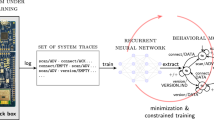Abstract
Synfire rings are important neural circuits capable of conveying synchronous, temporally precise and self-sustained activities in a robust manner. We describe a robust and optimal-size implementation of finite state automata with neural networks composed of synfire rings. More precisely, given any finite automaton, we build a corresponding neural network partly composed of synfire rings and capable of simulating it. The synfire ring activities encode the successive states of the automaton throughout its computation. The robustness of the network results from its architecture, which involves synfire rings and duplicated core components. We finally show that the network’s size is asymptotically optimal: for an automaton with n states, the network has \(\varTheta (\sqrt{n})\) cells.
Supports from DARPA – Lifelong Learning Machines (L2M) program, cooperative agreement No. HR0011-18-2-0023, as well as from the ICS CAS RVO: 67985807 and the Czech Science Foundation, grant No. 19-05704S, are gratefully acknowledged.
Access this chapter
Tax calculation will be finalised at checkout
Purchases are for personal use only
Similar content being viewed by others
References
Abeles, M.: Corticonics: Neuronal Circuits of the Cerebral Cortex. Cambridge University Press, Cambridge (1991)
Abeles, M.: Time is precious. Science 304(5670), 523–524 (2004). https://doi.org/10.1126/science.1097725
Cabessa, J., Horcholle-Bossavit, G., Quenet, B.: Neural computation with spiking neural networks composed of synfire rings. In: Lintas, A., Rovetta, S., Verschure, P.F.M.J., Villa, A.E.P. (eds.) ICANN 2017. LNCS, vol. 10613, pp. 245–253. Springer, Cham (2017). https://doi.org/10.1007/978-3-319-68600-4_29
Cabessa, J., Masulli, P.: Emulation of finite state automata with networks of synfire rings. In: 2017 International Joint Conference on Neural Networks, IJCNN 2017, Anchorage, AK, USA, May 14–19, 2017, pp. 4641–4648. IEEE (2017). https://doi.org/10.1109/IJCNN.2017.7966445
Cabessa, J., Siegelmann, H.T.: The super-turing computational power of plastic recurrent neural networks. Int. J. Neural Syst. 24(8), 1450029 (2014). https://doi.org/10.1142/S0129065714500294
Cabessa, J., Tchaptchet, A.: Automata computation with Hodgkin-Huxley based neural networks composed of synfire rings. In: 2018 International Joint Conference on Neural Networks, IJCNN 2018, Rio de Janeiro, Brazil, July 8–13, 2018, pp. 1–8. IEEE (2018). https://doi.org/10.1109/IJCNN.2018.8489700
Diesmann, M., Gewaltig, M.O., Aertsen, A.: Stable propagation of synchronous spiking in cortical neural networks. Nature 402, 529–533 (1999). https://doi.org/10.1038/990101
Hertz, J., Prügel-Bennett, A.: Learning synfire chains by self-organization. Netw.: Comput. Neural Syst. 7(2), 357–363 (1996). https://doi.org/10.1088/0954-898X_7_2_017
Hertz, J., Prügel-Bennett, A.: Learning synfire chains: turning noise into signal. Int. J. Neural Syst. 7(4), 445–450 (1996). https://doi.org/10.1142/S0129065796000427
Hopcroft, J.E., Motwani, R., Ullman, J.D.: Introduction to Automata Theory, Languages, and Computation, 3rd edn. Pearson international edition, Addison-Wesley, Boston (2007)
Horne, B.G., Hush, D.R.: Bounds on the complexity of recurrent neural network implementations of finite state machines. Neural Netw. 9(2), 243–252 (1996). https://doi.org/10.1016/0893-6080(95)00095-X
Ikegaya, Y., et al.: Synfire chains and cortical songs: temporal modules of cortical activity. Science 304(5670), 559–564 (2004). https://doi.org/10.1126/science.1093173
Indyk, P.: Optimal simulation of automata by neural nets. In: Mayr, E.W., Puech, C. (eds.) STACS 1995. LNCS, vol. 900, pp. 337–348. Springer, Heidelberg (1995). https://doi.org/10.1007/3-540-59042-0_85
Jun, J.K., Jin, D.Z.: Development of neural circuitry for precise temporal sequences through spontaneous activity, axon remodeling, and synaptic plasticity. PLOS One 2(8), 1–17 (2007). https://doi.org/10.1371/journal.pone.0000723
Kleene, S.C.: Representation of events in nerve nets and finite automata. In: Shannon, C., McCarthy, J. (eds.) Automata Studies, vol. 34, pp. 3–42. Princeton University Press, Princeton (1956). https://doi.org/10.1515/9781400882618-002
Levy, N., Horn, D., Meilijson, I., Ruppin, E.: Distributed synchrony in a cell assembly of spiking neurons. Neural Netw. 14(6–7), 815–824 (2001). https://doi.org/10.1016/S0893-6080(01)00044-2
Lupanov, O.B.: On the synthesis of threshold circuits. Probl. Kibernet. 26, 109–140 (1973)
Mainen, Z., Sejnowski, T.: Reliability of spike timing in neocortical neurons. Science 268(5216), 1503–1506 (1995). https://doi.org/10.1126/science.7770778
Minsky, M.L.: Computation: Finite and Infinite Machines. Prentice-Hall Inc., Englewood Cliffs (1967)
Siegelmann, H.T.: Neural Networks and Analog Computation: Beyond the Turing Limit. Birkhauser Boston Inc., Cambridge (1999)
Siegelmann, H.T., Sontag, E.D.: Analog computation via neural networks. Theor. Comput. Sci. 131(2), 331–360 (1994). https://doi.org/10.1016/0304-3975(94)90178-3
Siegelmann, H.T., Sontag, E.D.: On the computational power of neural nets. J. Comput. Syst. Sci. 50(1), 132–150 (1995). https://doi.org/10.1006/jcss.1995.1013
Šíma, J.: Energy complexity of recurrent neural networks. Neural Comput. 26(5), 953–973 (2014). https://doi.org/10.1162/NECO_a_00579
Šíma, J., Orponen, P.: General-purpose computation with neural networks: a survey of complexity theoretic results. Neural Comput. 15(12), 2727–2778 (2003). https://doi.org/10.1162/089976603322518731
Šíma, J., Wiedermann, J.: Theory of neuromata. J. ACM 45(1), 155–178 (1998). https://doi.org/10.1145/273865.273914
Zheng, P., Triesch, J.: Robust development of synfire chains from multiple plasticity mechanisms. Front. Comput. Neurosci. 8(66) (2014). https://doi.org/10.3389/fncom.2014.00066
Author information
Authors and Affiliations
Corresponding author
Editor information
Editors and Affiliations
Rights and permissions
Copyright information
© 2019 Springer Nature Switzerland AG
About this paper
Cite this paper
Cabessa, J., Šíma, J. (2019). Robust Optimal-Size Implementation of Finite State Automata with Synfire Ring-Based Neural Networks. In: Tetko, I., Kůrková, V., Karpov, P., Theis, F. (eds) Artificial Neural Networks and Machine Learning – ICANN 2019: Theoretical Neural Computation. ICANN 2019. Lecture Notes in Computer Science(), vol 11727. Springer, Cham. https://doi.org/10.1007/978-3-030-30487-4_62
Download citation
DOI: https://doi.org/10.1007/978-3-030-30487-4_62
Published:
Publisher Name: Springer, Cham
Print ISBN: 978-3-030-30486-7
Online ISBN: 978-3-030-30487-4
eBook Packages: Computer ScienceComputer Science (R0)




